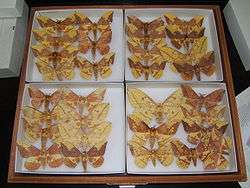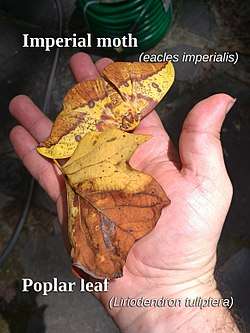Eacles imperialis
| Eacles imperialis | |
|---|---|
| | |
| Eacles imperialis, adult male | |
| Scientific classification | |
| Kingdom: | Animalia |
| Phylum: | Arthropoda |
| Class: | Insecta |
| Order: | Lepidoptera |
| Family: | Saturniidae |
| Genus: | Eacles |
| Species: | E. imperialis |
| Binomial name | |
| Eacles imperialis (Drury, 1773) | |
Eacles imperialis (imperial moth) is a Nearctic member of the family Saturniidae and subfamily Ceratocampinae. The wingspan of an adult is between 80–175 mm ( 3 1⁄8 and 6 7⁄8 inches).[1]
Description


There is a high amount of variation within this species. The colors of the adult are always yellow and purple but can vary distinctly on this. Generally there is more purple on the forewing and more purple on males. However, one subspecies tends to have a distinct coating of purple over the entire wings.
Darker, heavily mottled individuals are typical forms of the southern and western range and may represent a clinal variation of nominate E. i. imperialis. Subspecies E. i. pini to the north, and sibling species Eacles oslari to the southwest exhibit similar morphs. Regional food plant preferences have been noted as well, although captive-bred populations from all sources are nearly omnivorous.
Distribution
Imperial moths (their many regional morphs, subspecies, and sibling species) range from South America to Canada and from the Rocky Mountains to the Atlantic Coast, where their colloquial name is "Mothra." Nominate Eacles imperialis imperialis has been recorded historically from New England and southern Canada, south to the Gulf of Mexico and west across the Great Plains. In modern times, its range has receded northward (where it was always a good find); it is considered common south of the Mason-Dixon line. Subspecies E. i. pini occurs in coniferous and transition zone woodlands at the northern edges of the New England and Great Lakes States and northward into Canada. In the southwest it is replaced by the closely related E. oslari. Other sub species are found in Mexico and South America.
Subspecies
The subspecies of Eacles imperialis:
- E. i. imperialis (Drury, 1773)
- E. i. pini (Michener, 1950)
- E. i. cacicus (Boisduval, 1868)
- E. i. hallawachsae (Brechlin & Meister, 2011)
- E. i. quintanensis (Lemaire, 1971)
- E. i. decoris (Rothschild, 1907)
- E. i. tucumana (Rothschild, 1907)
- E. i. opaca (Burmeister, 1878)
- E. i. piurensis (Brechlin & Meister, 2011)
- E. i. nobilis (Neumoegen, 1891)
- E. i. magnifica (Walker, 1855)
- E. i. anchicayensis (Lemaire, 1971)
Status
Eacles imperialis is one of a few saturniid species in a regional decline throughout the northeastern US, with some New England states lacking records for many decades. A colony on Martha's Vineyard, Massachusetts, has been the subject of scientific and local political activity, especially concerning preservation of sensitive frost-bottom oak/pine habitat. Reasons for decline are unclear, as are the true northern limits of the nominate's range, due to possible confusion with subspecies E. i. pini in existing records. E. imperialis is certainly a common species of middle-atlantic states, Appalachia, the Ohio Valley, and Deep South regions, and is associated with forest, rural and suburban habitat. It is possible that to the north, E. imperialis requires specific habitat and that the increasing fragmentation of niches such as coastal or montane pine barrens is a factor.
Life cycle
There is only one brood a year.[1]
Egg
The eggs hatch in roughly two weeks.
Larva
The caterpillars tend to wander before settling down to eat. The first instar generally lasts only a few days. At the end of each instar, a small amount of silk is spun on the major vein of a leaf. The caterpillar then latches onto the silk with its anal claspers and prolegs and begins to molt. It first becomes dormant and undergoes apolysis, then after an additional day or so, undergoes ecdysis. The caterpillar emerges from its old exoskeleton, puffs up, and hardens as it enters the next instar. This species will sometimes eat the old exoskeleton for protein nutrition. Similar to many other Saturniidae caterpillars, the imperial moth has five instars. By the third instar, variation between caterpillars can be observed. This species is known to have two basic color forms, a black-orange form and a green-yellow form. There is also variation within those two forms on the head, spines, body, and feet. At the end of the fifth instar, the caterpillar will leave the tree and travel along the ground in search of a soft soil patch in which to pupate.
Pupa
As with most of this subfamily, when the caterpillars are ready to pupate, they burrow underground.
Adult
Adults emerge once a year to mate. In the northern part of their range they tend to emerge mid summer (June–August), while in the southern half they tend to emerge at more varied times (April–October). A linked pair is vulnerable to predators, particularly foraging raccoons.[1]
As with all of Saturniidae, the adults do not feed.[1] Their mouthparts have been reduced.
Sexual dimorphism
Sexual dimorphism is present in this species and all of Saturniidae :
- The males are generally smaller and show larger patches of purple
- The females are generally larger, mostly from carrying eggs, and are more yellow
- The antenna of the male is fibrous
- The female's rear end is slightly bigger
Food plants
Larvae feed on a variety of host plants including:
- Quercus (oak)
- Acer (maple)
- Liquidambar styraciflua (American sweetgum)
- Sassafras albidum (sassafras)
- Pinus (pine)
References
- 1 2 3 4 "Imperial moth Eacles imperialis (Drury, 1773)". Butterflies and Moths. Retrieved February 27, 2015.
External links
| Wikimedia Commons has media related to Eacles imperialis. |
- Eacles imperialis, Moth Photographers Group